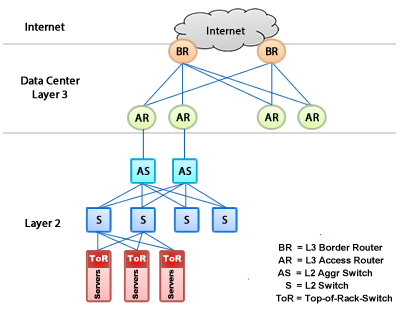
4.4.2. Data centre and cloud architecture intertwined
See the following figure:
It presents a typical three-layer architecture of a large data centre. The top layer provides access to the infrastructure below. It leverages Layer 3 (IP) to route traffic in and out of the data centre, and the Border and Access Routers there provide access and redundancy of connection to/from the Internet. The middle one, is responsible for aggregation of traffic and directing it towards Aggregation Routers (outgoing) and internal switches (incoming). These typically operate on Layer 2 as well as the top-of-the-rack ToR switches and underlying physical servers constituting the core layer of the data centre -- actually providing the service (storage, computation, etc.)
On top of this, for each rack server there can be a number of virtual machines (VMs) running under a hypervisor (such as VmWare or Xen), which provides additional virutal switches and routers. Moreover, the VMs and whole rack servers can be grouped into Virtual Local Area Networks (VLANs) and internal switches and access switches can also be configured to support this inner partitioning, and "VLAN Trunking" on the Layer~3 be employed to push VLAN packets accross Access Routers. On the whole, the resulting network of connections is quite complex and, more importantly, dynamically changing as VMs are brought up or down.
